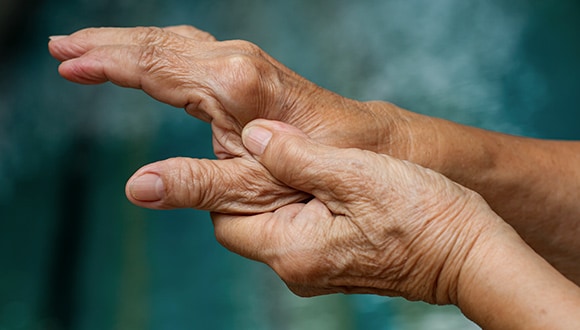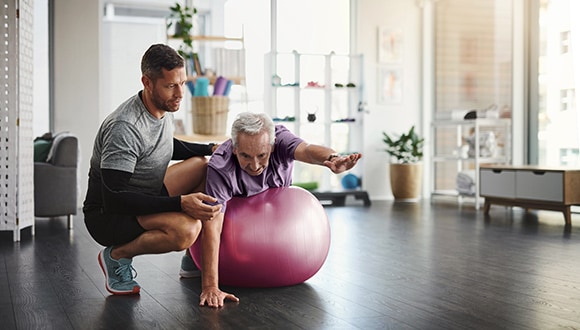Arthritis: How you may get treatment and relief
Updated July 2023 | 6 min read
Expert contributor Professor Patrick McNeil, Deputy Vice-Chancellor, Medicine and Health, Macquarie University
Words by Katherine Chatfield
Arthritis often starts with joint pain and stiffness. Here’s a guide to the different types of arthritis and ways to manage each type.
If you’re experiencing mystery aches and pains, particularly in your hands, hips or knees, it’s time to start taking notice. Arthritis often starts with joint pain and stiffness, so it’s important you don’t dismiss any twinges in your body.
Although arthritis is commonly thought of as an older person’s issue, it can affect people of all ages. 3.6 million Aussies are living with the condition and it’s predicted that figure will rise to 5.4 million by 2030. Around 55% of these people are aged between 15 and 64.
"In Western countries, arthritis is a modern epidemic," says Professor Patrick McNeil, rheumatologist, deputy vice chancellor, Medicine and Health, at Macquarie University and former chair of Arthritis Australia. "Our lifestyle often leads to obesity, which is a major risk factor for many types of arthritis, including osteoarthritis.
"The other contributing factor to the growing statistics is that people are living longer. The longer someone lives, the more likely it is they will develop a variety of health conditions – including arthritis."
Whatever you do, don’t dismiss aches and pains. "Early diagnosis is the key," confirms Prof McNeil. "If you’re experiencing joint pain, no matter what your age, see your GP."
Here’s a guide to the different types of arthritis, and how to help treat them.
Rheumatoid arthritis
What it is: Rheumatoid arthritis is an autoimmune disease that may cause hand, feet, knee and hip joints to swell painfully, which can be very debilitating if not treated appropriately and quickly. It’s the second most common type of arthritis in Australia. "Also known as RA, it affects 2% of our population," says Prof McNeil.
What can cause it: Family history of the condition and genetics are the greatest risk factors for rheumatoid arthritis, but smoking is the strongest behavioural risk factor and is further increased when there are genetic risks, too.
How you can treat it: Although there’s no cure for rheumatoid arthritis, there are many strategies to help manage the condition. Talk to your GP about different types of painkillers: corticosteroids, which can reduce inflammation, or disease-modifying anti-rheumatic drugs (DMARDs) which may slow the progression of the disease.

Osteoarthritis
What it is: Osteoarthritis occurs in the knees, hips, fingers and toes. It may affect the bone, cartilage, ligaments and muscles of the joint. Symptoms can include pain, stiffness in the joints and reduced mobility. "Osteoarthritis [OA] is the most common form of arthritis in Australia, with 8% of the population diagnosed," says Prof McNeil. "However, many people don’t know they have OA, so this figure is likely to be much higher."
What can cause it: Risk factors include being overweight, previous injuries to the joints and a family history of the condition.
How you can treat it: There is no cure for OA, but it can be managed by weight loss, exercise, pain medication and, if necessary, walking frames and sticks. Joint-replacement surgery is an option in advanced cases.
Our No-Gap Joints program for primary hip and knee replacements gives eligible members peace of mind, with no out-of-pocket costs from hospital admission through to discharge and post-surgery rehab* (excess may be payable under your policy). We've partnered with selected private hospitals and clinicians in NSW and Victoria to give greater flexibility and continuity of care while keeping costs down.
Eligible members can also access the Osteoarthritis Healthy Weight for Life^ program, designed especially for people suffering from osteoarthritis of the knee and hip joints. The program aims to support you to reduce the pain in your joints, improve your mobility or prepare for hip or knee surgery.
Psoriatic arthritis
What it is: This type of arthritis is linked to the chronic skin disease, psoriasis. Around one in 10 people who have psoriasis also have psoriatic arthritis. It may cause joint swelling and pain, as well as foot pain and lower back pain. As with psoriasis, it can flare up or go into remission at certain times.
What can cause it: It’s not clear what causes psoriatic arthritis, however it’s believed your immune system and genetic makeup may play a part, as can environmental factors.
How you can treat it: A rheumatologist can diagnose psoriatic arthritis. It’s important you make sure you get the right treatment. Physiotherapy or occupational therapy may be recommended, alongside anti-inflammatories like ibuprofen, or disease-modifying anti-rheumatic drugs, which can help control an overactive immune system.

Ankylosing spondylitis
What it is: Ankylosing spondylitis (AS) may affect the joints in the neck, back, pelvis, hips and shoulders, which become inflamed, painful and stiff. "It's an inflammatory arthritis that can be very damaging and life changing," says Prof McNeil. "The pain is often worse after resting or sitting for prolonged periods, and tends to be less severe with exercise."
What can cause it: There is no known cause of AS, but research suggests a gene is present in most people who have it.
How you can treat it: Modern treatments have revolutionised the outlook for those with the condition. "Some new medications [may] relieve the symptoms of AS," says Prof McNeil. "In fact, the research and advances in treatment are the biggest in arthritis treatment for many years."
Septic arthritis
What it is: Septic arthritis, also known as infectious arthritis, is a bacterial, viral or fungal infection in a joint. Symptoms may include redness, pain, swelling and heat around the joint.
What can cause it: Septic arthritis is usually caused by a skin infection or urinary tract infection (UTI) spreading through your bloodstream to a joint. It’s most common in children and older adults, or people who have artificial joints.
How you can treat it: Antibiotics should be taken immediately and usually ease symptoms within 48 hours. In severe cases, pus might be drained from the joint with a needle or in surgery.
Reactive arthritis
What it is: This joint pain and swelling is triggered by another infection in the body – usually the urinary tract, genitals or intestines. It usually causes inflammation to the knees, ankles and feet. It’s an uncommon form of arthritis and often clears up in around 12 months.
What can cause it: Bacteria in another part of your body can trigger reactive arthritis. This bacteria is usually transmitted sexually, or appears in food, like salmonella. It’s most common in adults aged between 20 and 40.
How you can treat it: Antibiotics are usually prescribed to treat the initial infection, although there’s no treatment specifically for reactive arthritis. Pain relief like ibuprofen can reduce inflammation, and corticosteroid injections in the affected joints may also help reduce pain and swelling.
Gout
What it is: Gout is a type of arthritis that occurs when the body’s uric acid isn’t excreted. Instead, it turns into crystals that deposit in and around joints. This can result in inflammation, pain and swelling of the toes, feet, hands, wrists, knees and elbows – particularly the big toe. Gout is episodic, which means it comes and goes. "Gout is very common in Australia and there is a misconception that it's caused by alcohol, not arthritis," explains Prof McNeil.
What can cause it: Gout usually occurs in people with a family history of the condition, or because of lifestyle factors like obesity, overeating, not drinking enough water, crash dieting, excessive alcohol consumption and eating and drinking purine-rich foods like processed meat. It’s also more common in males over 65.
How you can treat it: Applying ice and elevating the joint can ease the pain of gout. Anti-inflammatory medicines like ibuprofen can help, although aspirin isn’t recommended. If you have regular bouts of gout, some medications can help to lower the uric acid in your blood.
A GP at your fingertips
If you’re experiencing joint pain or stiffness or any health concerns, speak to your doctor.
We know it can be hard to manage your health in a convenient way. Our partnership with GP2U, an online video GP service, makes it easier for you to access telehealth services.
All HCF members with health cover can access a standard online video GP consultation (up to 10 minutes) for a fee of $50. See hcf.com.au/gp2u for more information.
NO-GAP JOINTS PROGRAM THAT PUTS YOU IN CONTROL
Have you been delaying joint replacement surgery because it’s too daunting or haven’t been able to afford it? Our No-Gap Joints* program makes it easier for you to take back control of your health.
Related articles
HOW TO EXERCISE 5 HOURS A WEEK
Carving out time to hit the recommended daily amount of exercise doesn’t have to be challenging. Here’s how to build up your endurance.
A GUIDE TO PSORIASIS
This common skin condition can be debilitating. Here’s how to get the right treatment and start feeling better.
HOW PHYSIOTHERAPY WORKS
It can help repair damage, reduce stiffness and pain, increase mobility and improve quality of life.
KNEE SURGERY ALTERNATIVES
Knee-replacement surgery may not be the best solution for painful osteoarthritis.
IMPORTANT INFORMATION
* Eligible members will need to have HCF hospital cover including primary hip and knee replacements for 12 months (excluding Overseas Visitors Health Cover). Members must meet clinical criteria and be accepted into the program by a participating clinician and hospital. Program is only available at participating hospitals for a limited time. For full program terms and conditions, including list of participating hospitals and program end dates, visit hcf.com.au/nogapjoints
^ Eligibility criteria applies. For more information see hcf.com.au/hwfl
This communication contains information which is copyright to The Hospitals Contribution Fund of Australia Limited (HCF). It should not be copied, disclosed or distributed without the authority of HCF. Except as required by law, HCF does not represent, warrant and/or guarantee that this communication is free from errors, virus, interception or interference. All reasonable efforts have been taken to ensure the accuracy of material contained on this website. It’s not intended that this website be comprehensive or render advice. HCF members should rely on authoritative advice they seek from qualified practitioners in the health and medical fields as the information provided on this website is general information only and may not be suitable to individual circumstances or health needs. Please check with your health professional before making any dietary, medical or other health decisions as a result of reading this website.